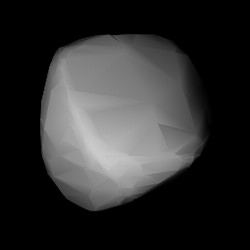
Summary
3430 Bradfield (prov. designation: 1980 TF4) is a stony Agnia asteroid from the central regions of the asteroid belt, approximately 8 kilometers (5 miles) in diameter. It was discovered on 9 October 1980, by American astronomer Carolyn Shoemaker at the Palomar Observatory in California. The Sq-type asteroid was named after comet hunter William A. Bradfield.[1]
 Shape model of Bradfield from its lightcurve | |
| Discovery [1] | |
|---|---|
| Discovered by | C. Shoemaker |
| Discovery site | Palomar Obs. |
| Discovery date | 9 October 1980 |
| Designations | |
| (3430) Bradfield | |
Named after | William A. Bradfield (discoverer of comets) |
| 1980 TF4 · 1974 HY1 1976 YS7 | |
| main-belt [1][2] · (middle) Agnia [3] | |
| Orbital characteristics [2] | |
| Epoch 23 March 2018 (JD 2458200.5) | |
| Uncertainty parameter 0 | |
| Observation arc | 43.93 yr (16,044 d) |
| Aphelion | 3.0293 AU |
| Perihelion | 2.4890 AU |
| 2.7592 AU | |
| Eccentricity | 0.0979 |
| 4.58 yr (1,674 d) | |
| 102.11° | |
| 0° 12m 54s / day | |
| Inclination | 4.4281° |
| 43.225° | |
| 278.60° | |
| Physical characteristics | |
Mean diameter | 8.492±0.263 km[4] |
| 0.269±0.035[4] | |
| SMASS = Sq [2] | |
| 12.5[1][2] | |
Orbit and classification edit
When applying the hierarchical clustering method to its proper orbital elements according to Nesvorný, Bradfield is a member of the Agnia family (514),[3] a very large family of stony asteroids with more than 2000 known members.[5] They most likely formed from the breakup of a basalt object, which in turn was spawned from a larger parent body that underwent igneous differentiation.[6] The family's parent body and namesake is the asteroid 847 Agnia.[5] In the 1995-HCM analysis by Zappalà, however, it is a member of the Liberatrix family (also described as Nemesis family by Nesvorný).[3][7]
It orbits the Sun in the central main-belt at a distance of 2.5–3.0 AU once every 4 years and 7 months (1,674 days; semi-major axis of 2.76 AU). Its orbit has an eccentricity of 0.10 and an inclination of 4° with respect to the ecliptic.[2] The body's observation arc begins with its observations as 1974 HY1 at Cerro El Roble Observatory in April 1974, more than 6 years prior to its official discovery observation at Palomar.[1]
Naming edit
This minor planet was named after New Zealand-born Australian amateur astronomer and rocket engineer William A. Bradfield (1927–2014). A discoverer of several comets himself, he significantly increased the rate of discovery of bright comets from the southern hemisphere during the 1970s and 1980s.[1] The official naming citation was published by the Minor Planet Center on 14 April 1987 (M.P.C. 11750).[8]
Physical characteristics edit
In the SMASS classification, Bradfield is an Sq-subtype, that transitions between the common, stony S-type and Q-type asteroids.[2]
Diameter and albedo edit
According to the survey carried out by the NEOWISE mission of NASA's Wide-field Infrared Survey Explorer, Bradfield measures 8.492 kilometers in diameter and its surface has an albedo of 0.269.[4]
Rotation period edit
As of 2018, no rotational lightcurve of Bradfield has been obtained from photometric observations. The body's rotation period, pole and shape remain unknown.[2]
References edit
- ^ a b c d e f "3430 Bradfield (1980 TF4)". Minor Planet Center. Retrieved 12 April 2018.
- ^ a b c d e f g "JPL Small-Body Database Browser: 3430 Bradfield (1980 TF4)" (2018-03-28 last obs.). Jet Propulsion Laboratory. Retrieved 12 April 2018.
- ^ a b c "Asteroid 3430 Bradfield – Nesvorny HCM Asteroid Families V3.0". Small Bodies Data Ferret. Retrieved 26 October 2019.
- ^ a b c Masiero, Joseph R.; Mainzer, A. K.; Grav, T.; Bauer, J. M.; Cutri, R. M.; Dailey, J.; et al. (November 2011). "Main Belt Asteroids with WISE/NEOWISE. I. Preliminary Albedos and Diameters". The Astrophysical Journal. 741 (2): 20. arXiv:1109.4096. Bibcode:2011ApJ...741...68M. doi:10.1088/0004-637X/741/2/68.
- ^ a b Nesvorný, D.; Broz, M.; Carruba, V. (December 2014). "Identification and Dynamical Properties of Asteroid Families". Asteroids IV. pp. 297–321. arXiv:1502.01628. Bibcode:2015aste.book..297N. doi:10.2458/azu_uapress_9780816532131-ch016. ISBN 9780816532131.
- ^ Sunshine, Jessica M.; Bus, Schelte J.; McCoy, Timothy J.; Burbine, Thomas H.; Corrigan, Catherine M.; Binzel, Richard P. (August 2004). "High-calcium pyroxene as an indicator of igneous differentiation in asteroids and meteorites". Meteoritics and Planetary Science. 39 (8): 1343–1357. Bibcode:2004M&PS...39.1343S. doi:10.1111/j.1945-5100.2004.tb00950.x. Retrieved 12 April 2018.
- ^ Zappalà, V.; Bendjoya, Ph.; Cellino, A.; Farinella, P.; Froeschle, C. (1997). "Asteroid Dynamical Families". NASA Planetary Data System: EAR-A-5-DDR-FAMILY-V4.1. Retrieved 19 March 2020.} (PDS main page)
- ^ "MPC/MPO/MPS Archive". Minor Planet Center. Retrieved 12 April 2018.
External links edit
- Lightcurve Database Query (LCDB), at www.minorplanet.info
- Dictionary of Minor Planet Names, Google books
- Asteroids and comets rotation curves, CdR – Geneva Observatory, Raoul Behrend
- Discovery Circumstances: Numbered Minor Planets (1)-(5000) – Minor Planet Center
- 3430 Bradfield at AstDyS-2, Asteroids—Dynamic Site
- Ephemeris · Observation prediction · Orbital info · Proper elements · Observational info
- 3430 Bradfield at the JPL Small-Body Database


